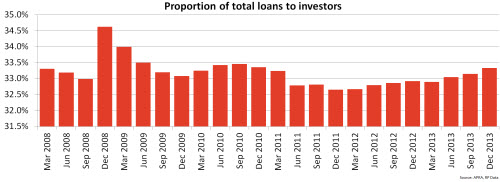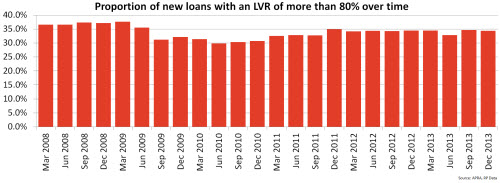
Each quarter the Australian Prudential Regulation Authority (APRA) publishes data on the exposure of Australian Authorised Deposit-taking Institutions (ADI).
The data is extremely useful as it provides highlights of all outstanding exposures (mortgages) and also some information about those loans written over the quarter.
To continue reading the rest of this article, please log in.
Looking for more benefits? Become a Premium Member.
Create free account to get unlimited news articles and more!
Looking for more benefits? Become a Premium Member.
The data indicates that across all ADIs, 66.7 per cent of the value of outstanding loans is to owner-occupiers, with the balance (33.3 per cent) to investors. Over time there has been little change to these proportions.

The data also highlights some information on those residential loans written over each quarter. Over the final quarter of 2013, a record high 35.7 per cent of new loans were for investment purposes, up from 34.4 per cent in September 2013 and 32.8 per cent in December 2012. Housing finance data indicates the current level of investor lending is at its highest point since late 2003, and not far off all-time highs.
This will be an area of the lending market APRA will be closely monitoring for two key reasons.
First, the vast majority of investment loans are interest-only mortgages, mainly due to the taxation benefits they afford. The APRA data shows that a record high 35.0 per cent of all outstanding loans (including both owner occupier and investment loans) are interest-only mortgages. This figure is up from 34.6 per cent at the end of the September 2013 quarter and 33.8 per cent in December 2012.
Our market intelligence suggests that the level of interest-only investment loan new lending activity is much higher, around the 90 per cent range. That is, roughly nine in every ten investment loans currently being advanced are interest only.
This is supported by the fact that over the last quarter of 2013, the proportion of interest-only mortgages advanced hit a record high of 38.8 per cent, up from 37.2 per cent the previous quarter and 35.0 per cent at the same time the previous year.
Second, for the same taxation reasons, the vast majority of investment loans are high LVR mortgages. Over the final quarter of 2013, 34.4 per cent of all new loans had an LVR of more than 80 per cent, which was down slightly from 34.6 per cent over the September 2013 quarter and the same proportion as in the December 2012 quarter. Although there has been a slight reduction, the proportion of higher LVR lending remains quite high.

This data indicates that the prevalence of investment loans with high LVR and interest-only loan characteristics is certainly a material part of the market. These loans are likely to come under stress in the event of an economic downturn given investors:
• are starting off with less equity in the property at the outset;
• are not paying off principal throughout the loan term; and
• have less emotional attachment to an investment property than an owner occupier and are therefore more likely to ‘hand over the keys’ in the event they come under severe financial pressure, certainly before they would ever likely do so in respect of their owner occupied property.
Whilst any investment loan losses are likely to be cross collateralised with other security (and are also likely to be insured with an LMI) and may therefore not represent a material risk to financial institutions, experience on the Gold Coast, Sunshine Coast and North Queensland over recent years has demonstrated the adverse impact that distressed property sales caused by investors exiting a market can have on the local economy.
 Login
Login









